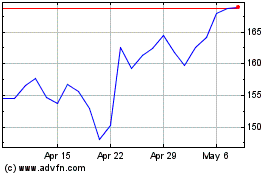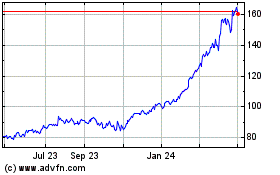SEC Provides Fewer Warnings of Potential Civil Action
October 26 2020 - 5:59AM
Dow Jones News
By Mark Maurer
Fewer companies are receiving warnings of potential
civil-enforcement actions from the Securities and Exchange
Commission as businesses under investigation increasingly opt to
defend themselves before receiving a "Wells notice."
The notices -- like the one General Electric Co. said it
received in September over its accounting for reserves related to
an insurance business it has been trying to shrink for years -- are
letters of a possible enforcement action against the recipient for
a securities violation, and offer the recipients a chance to
respond.
But many companies are providing a defense to the SEC ahead of
the Wells notice by submitting a white paper, requesting a meeting
with the enforcement division or both.
"There is an equally robust pre-Wells process that has become
the norm," said Jacob Frenkel, chair of government investigations
and securities enforcement at law firm Dickinson Wright PLLC and
former senior counsel in the SEC's enforcement division.
The SEC sent at least six Wells notices to public companies
during its fiscal year ended Sept. 30, according to research firm
Audit Analytics' review of corporate disclosures. During the
previous fiscal year, companies disclosed no notices at all.
In the three full fiscal years under Chairman Jay Clayton,
between October 2017 and this past September, the SEC sent out an
average of 4.7 letters to companies, based on corporate
disclosures. In the preceding 16 years -- from 2002 to 2017 --
Wells notices averaged about 14 a year, Audit Analytics data show.
Over the past two decades, companies disclosed the highest number
of Wells notices in the mid-2000s, when they reported a combined 55
letters in fiscal years 2004 and 2005.
Companies are required to disclose material information, but
some Wells notices that are deemed immaterial may go
unreported.
An SEC spokeswoman said it isn't informative to draw conclusions
from the number of disclosed Wells notices, because investigations
can play out in many different ways. "What is clear from a look at
the cases brought to date is the vigorous work of the women and men
of the SEC's Enforcement Division to combat wrongdoing, compensate
harmed investors, and maintain confidence in the integrity and
fairness of our markets," she said in a written statement.
Disclosure of a Wells notice informs investors that the SEC's
enforcement division believes it has enough material to build a
case against a company that goes beyond just an investigation. Such
notices also serve as the last stage before the start of formal
litigation. The Wells process and submission afford the SEC a
chance to gain insight into likely defenses the company would
mount, if a case were to go forward, Mr. Frenkel said.
The Wells notice usually isn't a surprise to the company under
investigation. The SEC and a company's counsel have usually spoken
extensively by that point. In recent months, large companies such
as General Electric and Under Armour Inc. have received these
warnings.
GE has fully cooperated with the SEC's investigation, a
spokeswoman said in a statement. "We strongly disagree with the
recommendation under consideration by the SEC staff and will
provide a response through the Wells notice process," she said. GE
declined to comment on its defense before receiving a Wells
notice.
Sportswear maker Under Armour this summer received a Wells
notice related to its past accounting practices. The company
declined to comment on whether it had provided any defense to the
SEC before the formal action.
Lawyers say some companies under investigation still prefer to
receive a formal Wells notice in order to make a Wells submission
and put their defenses and arguments directly in front of the
commission.
A Wells submission, in which the recipient provides a legal
defense, goes directly to the enforcement division staff, who can
respond in their memorandum recommending enforcement action.
Enforcement staff members send the Wells submission to the
commission along with their recommendation memorandum.
The SEC decides whether to proceed with an enforcement action
usually within 180 days of issuing the notice. The Wells process
could lead to the SEC shaving or adjusting charges or even deciding
to terminate the case.
Still, the noticeable drop in Wells notices also coincides with
the regulator's shift away from a rules-based approach to
disclosure.
The SEC, in the latest fiscal year, said it brought more than
700 enforcement actions. The actions may include charges,
settlements and delisting proceedings related to delinquent
filings. The total estimated figure marks a drop from 862 actions
during the previous fiscal year, though the regulator said a
significant percentage of the enforcement activity occurred during
the pandemic.
Write to Mark Maurer at mark.maurer@wsj.com
(END) Dow Jones Newswires
October 26, 2020 05:44 ET (09:44 GMT)
Copyright (c) 2020 Dow Jones & Company, Inc.
GE Aerospace (NYSE:GE)
Historical Stock Chart
From Mar 2024 to Apr 2024

GE Aerospace (NYSE:GE)
Historical Stock Chart
From Apr 2023 to Apr 2024
